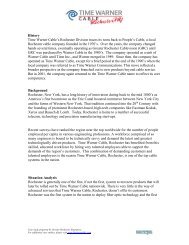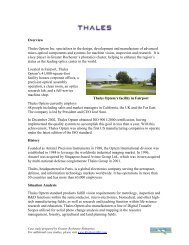OPTICS, IMAGING AND PHOTONICS - Greater Rochester Enterprise
OPTICS, IMAGING AND PHOTONICS - Greater Rochester Enterprise
OPTICS, IMAGING AND PHOTONICS - Greater Rochester Enterprise
You also want an ePaper? Increase the reach of your titles
YUMPU automatically turns print PDFs into web optimized ePapers that Google loves.
UNIVERSITY OF<br />
ROCHESTER<br />
The Omega laser, the most powerful ultraviolet laser in the world, fires on its target with more<br />
than 100 times the power in the entire national power grid.<br />
Laboratory for Laser Energetics<br />
The University of <strong>Rochester</strong>’s Laboratory for Laser Energetics (LLE) is home to Omega, the world’s most powerful laser,<br />
which scientists from around the nation use in their quest to develop nuclear fusion as a reliable energy saver source. LLE’s<br />
laser system also allows scientists to conduct experiments that are important to increased understanding of U.S. nuclear<br />
weapons in the absence of testing.<br />
Center for Adaptive Optics<br />
The University of <strong>Rochester</strong> is an integral member of the National Science Foundation's Science and Technology Center for<br />
Adaptive Optics. The scientists and engineers in its laboratory are primarily focusing their efforts on the development of<br />
ophthalmic instrumentation equipped with adaptive optics, with the ultimate goal of commercialization.<br />
Biomedical Optics<br />
Biomedical optics is one of four areas of specialization available to students in UR’s Department of Biomedical<br />
Engineering (BME). Biomedical optics lab research is focused on exploring a variety of problems such as tissue<br />
spectroscopy, fluorescence photobleaching, plus a new way to gather more information from microscopy images,<br />
called fluorescence anisotropy.<br />
<strong>Rochester</strong> Center for Brain Imaging<br />
Watching the human brain in action is the goal for scientists at the new <strong>Rochester</strong> Center for Brain Imaging. Its centerpiece<br />
is a new MRI system with a resolution far better than MRIs normally used in standard clinical situations. The new machine<br />
will use a 3.0 Tesla magnet twice the strength of those in standard machines. Only about 30 such MRIs exist in the nation.<br />
Center for Optics Manufacturing<br />
Machines that can grind ultra-precise optics into shapes once considered prohibitively expensive are now a reality, thanks<br />
to researchers at the University of <strong>Rochester</strong>’s Center for Optics Manufacturing. New conformal grinders create optics in<br />
shapes never before possible, and the revolutionary magnetorheological finishing technology uses a fluid to grind optics<br />
with unprecedented flexibility.<br />
University of <strong>Rochester</strong> Medical Center<br />
The University of <strong>Rochester</strong> School of Medicine and Dentistry ranks in the top 25% of medical schools in the most recent<br />
National Institute of Health (NIH) rankings. Many of its researchers benefit from the University’s long history of expertise in<br />
optics, stretching across traditional disciplinary lines to refine ultrasound imaging, magnetic resonance imaging and even<br />
spectroscopic detection of pathogens.<br />
Center for Visual Science<br />
The Center for Visual Science (CVS) is the preeminent center in the world for the complete study of vision from the cornea to<br />
the brain. It consists of more than 25 laboratories where researchers from diverse backgrounds study all aspects of vision<br />
such as the encoding of patterns of light by neurons in the retina, to the interaction between visual perception and memory.<br />
15








